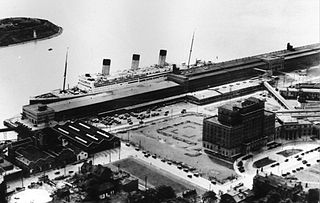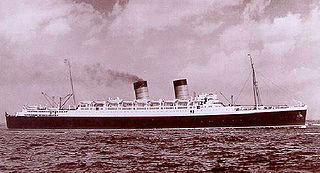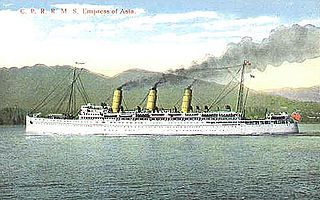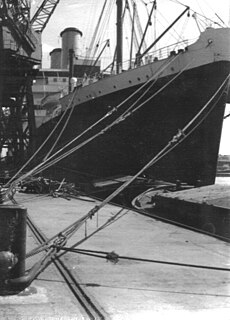This page is based on this
Wikipedia article Text is available under the
CC BY-SA 4.0 license; additional terms may apply.
Images, videos and audio are available under their respective licenses.

The RMS Queen Elizabeth was an ocean liner operated by Cunard Line. With Queen Mary she provided weekly luxury liner service between Southampton in the United Kingdom and New York City in the United States, via Cherbourg in France.

An ocean liner is a passenger ship primarily used as a form of transportation across seas or oceans. Liners may also carry cargo or mail, and may sometimes be used for other purposes.

Pier 21 was an ocean liner terminal and immigration shed from 1928 to 1971 in Halifax, Nova Scotia, Canada. Over one million immigrants came to Canada through Pier 21 and it is the last surviving seaport immigration facility in Canada. The facility is often compared to the landmark American immigration gateway Ellis Island. The former immigration facility is now occupied by the Canadian Museum of Immigration, the Nova Scotia College of Art and Design as well as various retail and studio tenants.

RMS Mauretania was launched on 28 July 1938 at the Cammell Laird yard in Birkenhead, England, and was completed in May 1939. The second Mauretania was the first ship built for the newly formed Cunard White Star company following the merger in April 1934 of the Cunard and White Star Line. On the withdrawal of the first RMS Mauretania in 1934, to prevent a rival company using the name and to keep it available for the new liner, arrangements were made for the Red Funnel paddle steamer Queen to be renamed Mauretania in the interim.

RMS Caronia was a British ocean liner, launched on 13 July 1904. She was built for Cunard by John Brown & Co. of Glasgow. She was the only ship in the Cunard fleet to be named after an American, being named after Caro Brown, granddaughter of Cunard's New York agent. She left Liverpool on her maiden voyage to New York on 25 February 1905. A successful 1906 cruise from New York to the Mediterranean led to Caronia's being used for cruising frequently in the coming years.

CP Ships was a large Canadian shipping company established in the 19th century. From the late 1880s until after World War II, the company was Canada's largest operator of Atlantic and Pacific steamships. Many immigrants travelled on CP ships from Europe to Canada. The sinking of the steamship RMS Empress of Ireland during World War I was the largest maritime disaster in Canadian history. The company provided Canadian Merchant Navy vessels in World Wars I and II. Twelve vessels were lost due to enemy action in World War II including the largest ship sunk by a German U-boat, RMS Empress of Britain.

The RMS Empress of Britain was an ocean liner built between 1928 and 1931 by John Brown shipyard in Scotland and owned by Canadian Pacific Steamship Company. This ship was the second of three CP vessels named Empress of Britain — provided scheduled trans-Atlantic passenger service from spring to autumn between Canada and Europe from 1931 until 1939.

RMS Empress of Britain was a transatlantic ocean liner built by Fairfield Shipbuilding at Govan on the Clyde in Scotland in 1905–1906 for Canadian Pacific Steamship (CP). This ship – the first of three CP vessels to be named Empress of Britain – regularly traversed the trans-Atlantic route between Canada and Europe until 1922, with the exception of the war years.

RMS Adriatic was an ocean liner of the White Star Line. She was the fourth of a quartet of ships measuring over 20,000 tons, dubbed The Big Four. The ship was the only one of the four which was never the world's largest ship; however, she was the fastest of the Big Four. Adriatic was the first ocean liner to have an indoor swimming pool and a Turkish bath.

RMS Empress of Japan, also known as the "Queen of the Pacific", was an ocean liner built in 1890–1891 by Naval Construction & Armaments Co, Barrow-in-Furness, England for Canadian Pacific Steamships (CP). This ship – the first of two CP vessels to be named Empress of Japan – regularly traversed the trans-Pacific route between the west coast of Canada and the Far East until 1922. During the First World War she served as armed merchant cruiser, becoming HMS Empress of Japan for the period that she was a commissioned ship of the Royal Navy.

RMS Empress of Australia was an ocean liner built in 1913–1919 by Vulcan AG shipyard in Stettin, Germany for the Hamburg America Line. She was refitted for Canadian Pacific Steamships; and the ship – the third of three CP vessels to be named Empress of China – was renamed yet again in 1922 as Empress of Australia..

RMS Empress of Asia was an ocean liner built in 1912–1913 by Fairfield Shipbuilding and Engineering at Govan on the Clyde in Scotland for Canadian Pacific Steamships.
Empress of Britain may refer to one of these Canadian Pacific Steamship Company ocean liners:

RMS Empress of Canada was an ocean liner launched in 1960 and completed the following year by Vickers-Armstrongs of Walker, Newcastle upon Tyne, England for Canadian Pacific Steamships Ltd.. This ship, the third CP vessel to be named Empress of Canada, regularly traversed the transatlantic route between Liverpool and Canada for the next decade. Although Canadian Pacific Railways was incorporated in Canada, the Atlantic liners were owned and operated by the British registered subsidiary Canadian Pacific Steamships Ltd. and were always British flagged and manned and therefore Empress of Canada was not the flagship of the Canadian Merchant Marine.

SS Orontes was a passenger ship owned by Orient Line.

The RMS Franconia was an ocean liner operated by the Cunard Line from 1922 to 1956. She was second of three liners named Franconia which served the Cunard Line, the others being RMS Franconia built in 1910 and the third Franconia in 1963.
RMS Samaria was transatlantic ocean liner built for Cunard Line. She served from 1922 until 1955. During the Second World War she was a troopship in the Royal Navy. Samaria was scrapped in 1956.

















